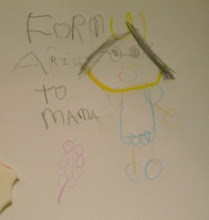
Ainsley, now at almost 18 months, has started self-feeding with a spoon. I remember the times when Ariel self-fed using a spoon at 18 months as well. In the U.S., it's almost a norm for children to start self-feeding (first by hands, then to using a spoon) at a very young age. Self-feeding using hands start as early as 9-10 months. However, back in Singapore, many children do not self-feed till about after 2 years old? Most parents are perhaps afraid of the mess?
Self-feeding is in fact, a rather important milestone for young children. It helps in their fine motor skills, as well as hand-eye coordination. By 18 months, most children are able to use a spoon fairly well, if given a chance to. Yes, self-feeding might be messy, but so far, for my children, there is very little mess. Here are some tips for 'mess-free' self-feeding.
1. Get the right equipment
Prior to self-feeding, make sure you get the right equipment. If you are afraid of the mess, you can lay a plastic mat/newspaper underneath the high chair to catch the spills. Let baby wear a bib. But most importantly, I feel, you should get the right spoon. Get a spoon, that is easy to handle. For both our kids, we love the Sassy Less Mess Toddler spoons. (Ainsley is using that in the photo above). It has a short and curved handle, making it easy for children to handle. It's also designed to let the food stay on the spoon. Besides the spoon, some may like to get a bowl with suction below, such that the bowl will stay on the table. Munchkin has bowls of such design.
2. Feed the right food
Secondly, start self-feeding using the right food. Try to choose food that are less fluid, so that it is easier for the children to handle. I have noticed that most children in Singapore are only fed porridge till about 3 years old. Porridge is great, but porridge which are too fluid makes self-feeding very difficult and messy. Besides, if they are served hot, it will be hard for the children to feed themselves. I like to begin self-feeding using mashed potato or pasta. Mashed potato is great as it is likely to stay on the spoon. Shaped pasta makes clean-ups a lot easier. Start also with just a little food in the bowl. Do not present the children with a large bowl of food all at once, because if they spill it, that's the end of lunch. Scoop just a little bit into a small bowl for the children.
3. Guide the children, and teach them not to make a mess.
Lastly and most importantly, it is essential to guide your child in self-feeding. If the children are left on their own, it is quite likely that they will use the food as paint for their faces. Guide your child to how he/she should hold a spoon. Using the hand-over-hand method, teach him/her to spoon the food from the bowl and bring the spoon to his/her mouth. You may have to do this a few times, before the child gets it. If the child wants to play with the spoon/food or wish to lift up the bowl, remove it immediatey and say, "No." Never allow them to play with food. To me, food is meant to be eaten and not to be wasted, so it will be a good thing to teach them from young, that they should not play with their food.
I have been using the above tips in getting the 2 girls to self-feed, with very little and almost no mess at all. Ariel could self-feed entire meal by 2 years old and Ainsley is now starting at 18 months. Personally, I feel that self-feeding is an important self-help skill children as young as 18 months can have. Self-feeding is also mostly fun for children at such age, and this makes eating a much more fun activity for them. With that, I don't have to worry about the children being picky about food.




No comments:
Post a Comment